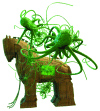Rise of the microbes
- PMID: 23334178
- PMCID: PMC3711979
- DOI: 10.4161/viru.23380
Rise of the microbes
Abstract
Infectious diseases continue to plague the modern world. In the evolutionary arms race of pathogen emergence, the rules of engagement appear to have suddenly changed. Human activities have collided with nature to hasten the emergence of more potent pathogens from natural microbial populations. This is evident in recent infectious disease outbreaks, the events that led to their origin, and lessons learned: influenza (2009), meningitis (Africa, 2009), cholera (Haiti, 2010), E. coli (Germany, 2011) and Salmonella (USA, 2012). Developing a comprehensive control plan requires an understanding of the genetics, epidemiology and evolution of emergent pathogens for which humans have little or no pre-existing immunity. As we plot our next move, nature's genetic lottery continues, providing the fuel to transform the most unlikely infectious disease scenarios into reality.
Keywords: Salmonella; Shiga toxin-producing E. coli; cholera; emerging pathogens; hypervirulence; infectious disease outbreaks; influenza; meningitis; microbial pathogenesis; vaccines.
Figures

Similar articles
-
Guarding against the most dangerous emerging pathogens.Emerg Infect Dis. 1996 Oct-Dec;2(4):245-57. doi: 10.3201/eid0204.960401. Emerg Infect Dis. 1996. PMID: 8969242 Free PMC article. Review.
-
Genomic analysis of emerging pathogens: methods, application and future trends.Genome Biol. 2014 Nov 22;15(11):541. doi: 10.1186/s13059-014-0541-9. Genome Biol. 2014. PMID: 25418281 Free PMC article. Review.
-
An easy operating pathogen microarray (EOPM) platform for rapid screening of vertebrate pathogens.BMC Infect Dis. 2013 Sep 20;13:437. doi: 10.1186/1471-2334-13-437. BMC Infect Dis. 2013. PMID: 24053492 Free PMC article.
-
Infectious history.Science. 2000 Apr 14;288(5464):287-93. doi: 10.1126/science.288.5464.287. Science. 2000. PMID: 10777411 No abstract available.
-
Molecular epidemiology: applications of nucleic acid amplification and sequence analysis.Epidemiol Rev. 1996;18(1):90-7. doi: 10.1093/oxfordjournals.epirev.a017919. Epidemiol Rev. 1996. PMID: 8877333 Review. No abstract available.
Cited by
-
Pandemic influenza virus: tracking a three-headed monster.Virulence. 2015;6(5):405-6. doi: 10.1080/21505594.2015.1020275. Epub 2015 Mar 4. Virulence. 2015. PMID: 25738965 Free PMC article. No abstract available.
-
Practical Guidance for Clinical Microbiology Laboratories: Diagnosis of Bacterial Gastroenteritis.Clin Microbiol Rev. 2015 Jan;28(1):3-31. doi: 10.1128/CMR.00073-14. Clin Microbiol Rev. 2015. PMID: 25567220 Free PMC article. Review.
-
Microfluidic chip-based detection and intraspecies strain discrimination of Salmonella serovars derived from whole blood of septic mice.Appl Environ Microbiol. 2013 Apr;79(7):2302-11. doi: 10.1128/AEM.03882-12. Epub 2013 Jan 25. Appl Environ Microbiol. 2013. PMID: 23354710 Free PMC article.
-
Comparative genomic and phenotypic characterization of invasive non-typhoidal Salmonella isolates from Siaya, Kenya.PLoS Negl Trop Dis. 2021 Feb 1;15(2):e0008991. doi: 10.1371/journal.pntd.0008991. eCollection 2021 Feb. PLoS Negl Trop Dis. 2021. PMID: 33524010 Free PMC article.
-
Competent with patients and populations: integrating public health into a medical program.BMC Med Educ. 2019 May 31;19(1):179. doi: 10.1186/s12909-019-1635-6. BMC Med Educ. 2019. PMID: 31151448 Free PMC article.
References
-
- Centers for Disease Control and Prevention (CDC) Swine influenza A (H1N1) infection in two children--Southern California, March-April 2009. MMWR Morb Mortal Wkly Rep. 2009;58:400–2. - PubMed
-
- Centers for Disease Control and Prevention Update: infections with a swine-origin influenza A (H1N1) virus-United States and other countries, April 28, 2009. Morbid Mortal Wkly Rep. 2009;58:431–3. - PubMed
Publication types
MeSH terms
LinkOut - more resources
Full Text Sources
Other Literature Sources
Medical
Research Materials
